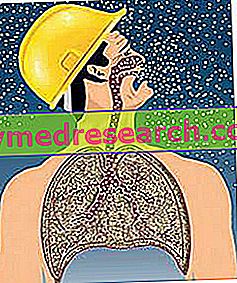Generality
Pneumoconioses are pulmonary diseases that arise following prolonged inhalation of organic and non-organic dusts.

Pneumoconiosis is a group of diseases caused by chronic inhalation, due to work causes, of powders capable of causing lung damage. From the site: legalnewsdaily.net
Belonging to the category of occupational diseases, pneumoconioses are characterized by their slow and gradual onset, and by the permanent damage they cause to the lungs.The main symptoms of pneumoconiosis are dyspnoea, chest pain, a sense of recurrent fatigue and cyanosis. At an advanced stage, a severe pneumoconiosis can also lead to the onset of lung cancer.
For a correct diagnosis, doctors use a thorough work history and some diagnostic imaging tests.
Unfortunately, pneumoconioses are currently incurable diseases.
What is pneumoconiosis
Pneumoconiosis is the term used to refer to a group of lung diseases, which are caused by prolonged and continuous inhalation of organic and non-organic dusts.
Pneumoconioses are diseases whose consequences appear very slowly. In fact, sometimes even more than 10 years can elapse since the sick person was constantly exposed to harmful dust. It is for this reason that people with pneumoconiosis are usually individuals over the age of 50.
MAIN CONSEQUENCES OF PNEUMOCONOSIS
The most serious pneumoconioses (malignant forms) are responsible for pulmonary granulomatosis and pulmonary fibrosis .
- Pulmonary granulomatosis is a condition characterized by the appearance, at the level of the lungs, of granulomas . Granulomas are circumscribed and nodular proliferations of connective tissue, which are formed due to an immune reaction. In the pneumoconiosis, the appearance of granulomas is the cause of the particles of toxic dust that reach the lungs and cause inflammation (granulomas from exogenous foreign bodies).
- Pulmonary fibrosis, on the other hand, is a disease marked by hardening and scarring of the lung tissue that surrounds and interposes between the alveoli . From a histological point of view, normal lung tissue disappears and is progressively replaced by so-called fibrotic tissue .
Pulmonary granulomatosis and pulmonary fibrosis make the lungs less elastic and prevent normal breathing.
Thus, pneumoconiosis patients suffer more or less severe respiratory disorders, depending on the number of granulomas present and the extent of fibrotic tissue.
What are alveoli?
The alveoli, more correctly called the pulmonary alveoli, are small cavities in the lungs, where gas exchange between the blood and the atmosphere takes place. Inside the alveoli, in fact, the blood is enriched with the oxygen contained in the air breathed and is "freed" of the carbon dioxide discarded by the tissues, after their spraying.
PNEUMOCONIOSIS ARE PROFESSIONAL DISEASES
Pneumoconioses are included in the list of so-called occupational diseases (or technopathies ). An occupational disease is a disease that an individual develops when working, due to the presence of harmful factors in the work environment.

The use of the so-called PPE (personal protective equipment), such as masks, coveralls, glasses and gloves, is extremely important to safeguard the health of workers exposed to the risk of pneumoconiosis
Occupational diseases differ from occupational accidents, as they occur in an almost immediate manner, while the former develop over time and gradually.
Attention: those who are diagnosed with pneumoconiosis, due to their past work, can apply for a professional disability.
Causes
Pneumoconiosis is caused by the inhalation of dust, fumes and substances containing silica, chromium, barium, graphite, coal, iron, tin, cobalt, asbestos, beryllium, cotton, malt, hay, barley, flax or hemp. The substances whose prolonged inhalation is harmful to the lungs are very numerous.
TYPES OF PNEUMOCONOSIS
Doctors and researchers have given pneumoconiosis different specific names, depending on the type of powder that is inhaled continuously.
Therefore, there are:
- Silicosis, due to inhalation of silica dust.
- Asbestosis due to inhalation and contact with asbestos and its dust.
- Berylliosis, due to inhalation and exposure to beryllium.
- Bixinosis, caused by the inhalation of cotton, linen or hemp powders.
- Siderosis, caused by the inhalation of ferruginous dust. Siderosis in the lungs is also commonly called "welders' lung".
- Kaolinosis (or kaolin pneumoconiosis ), induced by the inhalation of kaolin powder.
- Anthracose due to inhalation and contact with coal.
- Stannosis, caused by the inhalation of tin dusts.
- The pneumoconiosis from bauxite (or bauxite fibrosis ), due to the inhalation of bauxite dust, rock that contains mainly aluminum and silica.
- Baritosis, induced by the inhalation of barium dusts.
- Silicosiderosis, caused by the inhalation of silica and ferruginous dust.
- Pneumoconiosis from hard metals, induced by the inhalation of metal powders such as cobalt or tungsten.
- Graphitosis, caused by the inhalation of graphite powders.
SILICOSIS
Silica is a compound of silicon (Si), contained in many minerals commonly found in nature and which, together with oxygen, represent a large part of the earth's crust. They contain silica: sand, granite and sandstone rocks, flint, slate and many raw minerals.
As long as they are not processed, these minerals and rocks are harmless. When they suffer from drilling, cutting and / or crushing, they produce dust that, if you breathe for a long time and for many years, damages the lung tissue.
The people most at risk of silicosis are:
- Those who work in the mines, because they come into contact daily with minerals and quartz rocks.
- Those who work in the quarries of granite, gravel, sand and sandstone rocks.
- Ceramists and glassmakers
- Farmers
- Steelworks and foundry workers
- Those who work in the naval and railway industry
- Those who work in cement factories
ASBESTOSIS
Asbestos, or asbestos, is a set of minerals (inosilicates and phyllosilicates), arranged in elongated bodies called fibers.
With the manipulation of asbestos, the metal fibers that make it up can get lost in the air and be easily inhaled by those nearby.
The easy dispersion of asbestos fibers in the air is due to the conformation and the small size of the fibers themselves.
Before its abolition, asbestos was widely used in industrial plants, due to its resistance to fire, acids, micro-organisms and wear, and for its ductility.
The places of greatest exposure to asbestos were:
- The cement plants that produced Eternit
- The textile industries where asbestos-based fabrics, overalls and gloves were produced
- Shipyards and railways
- Building installations
- Friction materials industries, such as brakes and clutches
- Mining quarries for the minerals that make up asbestos
CAOLIN PNEUMOCONOSIS (OR CAOLINOSIS)
Kaolin is a rock made up mostly of kaolinite, a hydrosilicate aluminum mineral.
Kaolin is widely used in the production of ceramic products and in the pharmaceutical, cosmetic and paper industries.
ANTHRACOSIS AND STEEL

As far as siderosis is concerned, however, the people most exposed to this pneumoconiosis are those who work in the iron and steel industries, in foundries or in iron mines.
Symptoms and Complications
The typical symptoms and signs of pneumoconiosis are:
- Sense of oppression and chest pain
- Dyspnea (shortness of breath), both under stress ( dyspnea on exertion ) and at rest ( dyspnea at rest )
- Chronic dry cough
- Chronic bronchitis
- Respiratory problems
- Fatigue and sense of fatigue
- Cyanosis
- Pulmonary emphysema
- Increased heart rate (tachycardia)
- Bronchial noises
The speed of appearance and the severity of the aforementioned pathological manifestations depend on various factors, including:
- Exposure time to a given powder / substance. Clearly, the longer a person has come into contact with noxious powders over time, the more serious the symptoms will be.
- The heterogeneity of harmful powders inhaled during work. Often, those who work in industrial plants, miners or ceramists are exposed, during their working life, to various toxic substances capable of giving pneumoconiosis. This accelerates the processes of pulmonary granulomatosis and pulmonary fibrosis, and deepens the consequences at the level of the lungs.
COMPLICATIONS
During their course, several pneumoconioses (eg silicosis) are accompanied by chronic obstructive pulmonary disease ( COPD ), tuberculosis and autoimmune diseases ( scleroderma or rheumatoid arthritis ).
Furthermore, a prolonged situation of pulmonary fibrosis can lead to the onset of other serious pathological conditions, such as pulmonary hypertension, pulmonary heart, respiratory insufficiency and lung cancer (or lung carcinoma ).
The continuous inhalation of some powders is the cause not only of pneumoconiosis, but also of other serious diseases. Asbestos, for example, can cause asbestosis, but also pleural mesothelioma and peritoneal mesothelioma .
Diagnosis
Premise: if an individual has respiratory problems and claims to have been at risk for a long working period, doctors are expected to suspect a pneumoconiosis and shed light on the origin of the disorders.

RX-chest of an individual with anthracosis. The arrows indicate the areas of the lungs modified by the inhalation of coal dust.
The diagnostic protocol for pneumoconiosis requires, first of all, an accurate working history . This means that the doctor will ask the patient for information on the industrial sector in which he has served, the tasks performed, the tasks to which he was assigned and the duration of the work (to get an idea of how long exposure to the toxic substances).
For the past medical history (NB: the contribution that family members can make is also important), the doctor
- It analyzes the symptoms and signs accused by the patient (dyspnea, cough and bronchial noises are the most significant manifestations)
- Prescribes diagnostic imaging exams, such as chest X-ray or CT scan (if the RX-chest is unclear)
- Evaluate lung function
- Prescribes a lung biopsy
An accurate diagnosis also serves to establish the severity of the ongoing pneumoconiosis. Knowing the severity of the disease allows you to plan the most appropriate therapy.
Treatment
Unfortunately, pneumoconioses are incurable diseases, the consequences of which, at the level of the lungs, are irreversible. For example, the scar tissue that forms due to pulmonary fibrosis is permanent.
However, although healing is impossible, with appropriate symptomatic therapy it is possible to alleviate disorders and slow down the progression of the disease.
Possible treatments include corticosteroid drugs and immunosuppressants, oxygen therapy, respiratory rehabilitation and, finally, lung transplantation (reserved for more severe cases).
With regards to lifestyle, patients are advised to stop smoking (if they are smokers), avoid places frequented by smokers and adopt a healthy diet.
Prevention
Reducing the risk of pneumoconiosis to zero is difficult, if not impossible. The production of toxic dust should be kept to a minimum and workers exposed should be completely protected.
Prevention and protection measures, to be adopted in risky workplaces, consist of:
- Provide appropriate protective masks to workers that prevent dust inhalation.
- Keep the levels of harmful dust circulating in the air to a minimum.
- Ventilate the work environment in a suitable and periodic manner.
- Establish a plan for the periodical sanitization of the working environment and of the clothes used by workers (overalls, gloves, masks, etc.).
- Prepare a department (or area), where workers can wash and clean themselves properly from dust residues, before leaving the working environment.
Prognosis
Due to the lack of specific care, pneumoconiosis always has a negative prognosis.



